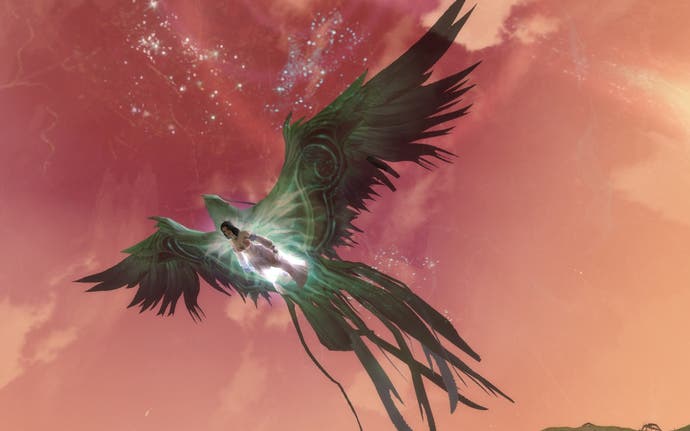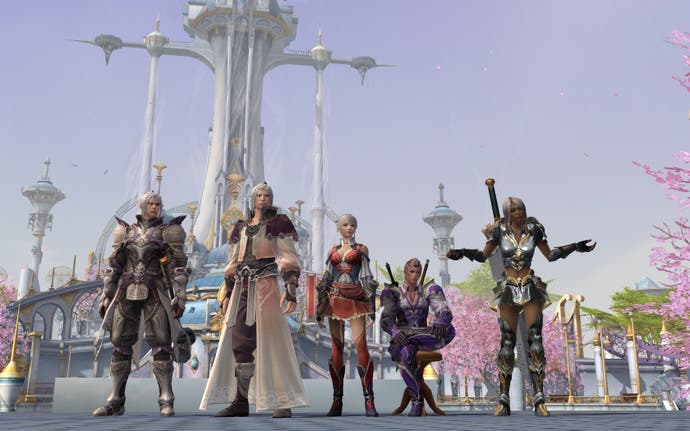Aion: Tower of Eternity
NCsoft gives you wings.
There's a general rule of thumb in the world of massively multiplayer RPGs: the easier on the eye a game's characters are, the harder work levelling them will be. It's a cultural split between Asia and the West. From the Eastern hemisphere, the likes of the Lineage games and Final Fantasy XI have sported flawless catalogue-model avatars, draped in filigree fantasy couture - but their existence is often far from glamorous, locked in a mindless experience grind of monster after monster that seems to have no end, or purpose.
Meanwhile, Western MMOs built on the EverQuest/World of Warcraft model offer incident-packed questing, spectacular dungeons, relatively fast levelling, deft storytelling and universes rich in detail and lore - peopled by grotesque anthropomorphic cartoons clad in spiked, primary-coloured fetish wear. Can't we have a life of beauty and ease?
NCsoft thinks so, and Aion: Tower of Eternity is the result. Guild Wars was a first stab at breaking down this divide, and very good it was too, although its short levelling curve, heavy instancing and player-versus-player focus took it some way off the beaten MMO track. Aion is different, or rather, it isn't.
This is pared-down, best-of-the-best fantasy MMORPG design from the old school, dressed in Sunday best. A divine war between two opposed races; eight character classes split neatly into four traditional archetypes (warrior, scout, mage and priest); six crafting professions; a level cap of 50; a single, persistent world on each server, with minimal use of instanced areas. It's all by-the-book stuff.
That's not to say that there aren't novelties. All characters get the ability to fly as early as level 10; the Abyss zone introduces a third, AI faction that will interfere in the player-versus-player war; and, most interestingly perhaps, there's the Stigma system, which will allow characters to equip the skills, spells and abilities of other classes.
Aion is a world inverted, and split in two. The landmasses are actually on the insides of two hemispheres, which were once connected by the titular Tower of Eternity. After a holy war to oust the dragon lords who overthrew Aion, the world's god, the Tower of Eternity was shattered, severing the two worlds. The dragon lords were banished to the Abyss that took the tower's place.

One of the hemispheres lives in the light of the sun, the other in perpetual dusk. On the former live the gorgeous, blessed Elyos; on the latter, the dark-skinned, clawed, maned, and still gorgeous Asmodians - the "fallen ones". Each faction considers the other evil, and will probably choose to express its hate in the form of griefing, making chicken noises and typing "LOL".
Appearance and homeworld areas aside, there's no difference between the Azmodians and Elyos: all character classes are open to both. Characters from both factions will "awaken" at level 10, becoming Daevas. Pronounced "Day-vuhs", this evolutionary leap does not come with big hair, a customisable NPC entourage, sequinned armour and the ability to make unreasonable rider demands; instead, you specialise your class archetype, acquire wings, and learn how to fly. Fair trade.
The class specialisation splits each archetype into two, although all of the final eight are deeply conventional designs, with no hybrids to speak of. Warriors become damage-dealing Gladiators or tanking Templars. Scouts become sneaky Assassins or bow- and snare-wielding Rangers. Mages can choose between Sorcerors, and deal direct magical damage, or Spirit-Masters, and summon a range of different pets. Priests take the path of the Cleric - a straight healer - or the Chanter, a defensive caster who can create magical shields and buff team-mates' attributes and abilities.
It's hard to go wrong with these class types - although you do have to worry about how easy the Chanter, say, will be to play solo - but it's also hard to get excited about them. Thankfully, this is where Aion's very interesting Stigma system comes in, offering hybridisation and easy customisation to every single class, in a nod to Guild Wars.

Stigmas stones, which drop from monsters or are handed out as quest rewards, are skills from other classes, and can be equipped by any class with very few restrictions. They might allow a Warrior to equip a Mage's spellbook and cast offensive magic (spellcasting is accompanied with a neat page-flipping animation), or a Mage to wear a Warrior's plate armour. You can collect any number of Stigma stones, but you can only equip a handful at a time; these can't be hot-swapped in combat, but can be changed by visiting a trainer and paying a small in-game fee. The most powerful skills will be rare drops, equivalent to a fine weapon or piece of armour; like other loot, some can be traded, and some will bind to the character.
By the sound of it, this device turns skills into loot, and should make character customisation both easy and massively flexible, without getting bogged down in Guild Wars' technical depth. Stigma completism could easily become as punishing an addiction as improving your gear. The Stigma system is both brilliant and obvious, and that's the hardest kind of design trick to pull off; hats off to NCsoft's internal Korean development team.
There are two further twists to combat skills. The first is a Divine Power bar, alongside the regular health and mana, that charges up as you play. This can be used for hugely-powerful super-skills, but will dissipate whenever you log off. Happily, you'll be able to transfer Divine Power to other players before you do, and it can even be used in crafting.


